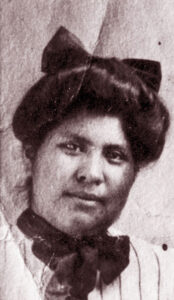By Deborah Osterberg
When one first thinks of Capitola, teeming summer beach crowds come to mind. But it was an annual offseason event in the early 20th century which helped raise the profile of the small, seaside resort.

Maggie Lafonso of Chico Rancheria • Courtesy of California State University, Chico, Meriam Library Special Collections
Each spring from 1900 through 1911, hundreds of coeds from western colleges descended upon Capitola for the Young Women’s Christian Association (YWCA) Pacific Coast Students’ Conference.
The YWCA, a non-sectarian Christian lay movement for women, is the oldest and largest multicultural women’s organization in the world. In the late 1890s the YWCA began to coordinate regional conferences for college women. The initial Pacific Coast Students’ Conference held at Capitola in May 1900 was a 10-day spring event attracting 115 delegates from 23 Western colleges and normal (teachers’) schools.
Capitola was one of four regional conferences held annually but soon became the most popular. Capitola’s scenery and resort attributes made “… it an ideal place for a religious gathering of earnest women …”
The conference provided young women the opportunity for Christian study, leadership training, networking, and recreation.
With his permission, the students took up residence at F.A. Hihn’s Hotel Capitola. The ladies were charged a $5.00 program fee and board at the hotel cost them just $1.00 per day. The conference attendees handled the hotel kitchen under the welcomed supervision of manager, Mrs. Patty Reed Lewis. The students also vividly decorated the hotel in their multiple school colors.
Phoebe Apperson Hearst donated funds to support the conference as well as paid the traveling expenses for many delegates. Hearst continued to be a major proponent and supporter of the conference, including later finding it a permanent home.
Young women with their college banners at YWCA conference hosted by F.A. Hihn’s Hotel Capitola, circa 1903 • Photograph taken by H.W.H. Penniman for the 1903 Y.W.C.A. souvenir booklet which F.A. Hihn commissioned as a gift for conference attendees. (Capitola Historical Museum)
Capitola’s location afforded delegates the opportunity to hold some of their sessions out on the beach. Though the main focus of the conference was spiritual learning, delegates were advised to pack “walking skirts, tennis racquets, kodaks, bicycles, etc.”
The girls’ free time was spent in all types of frolics including hiking, bonfires, gathering sea moss and shells and even putting on vaudeville shows. There was also an intercollegiate field day filled with running, baseball, and basketball competitions.
By year three, conference attendance tripled, far outpacing the growth of other regional conferences. Throughout the years there were large delegations from the two major universities (Berkeley and Stanford), groups of students from smaller colleges and city associations and occasionally girls from Indian boarding schools.
The Associations of more favored students pay the expenses of these Indian girls to Capitola; there they are the inspiration of all because of their spiritual earnestness and joy. They are marked Christian leaders afterwards in their schools, and may readily become leaders in their Indian communities …
One Native American conference attendee was 23-year-old Maggie Lafonso, also known as So-Wil-Len-No, of the Mechoopda Indians of the Chico Rancheria.
In 1905, famed women’s rights and temperance activist, Annie Bidwell, sent Maggie to the conference in her place. In a letter home Maggie wrote, “Have I ever been to such a glorious place as Capitola? … I have [met] many lovely ladies here …”
In addition to the Bible lessons and lectures on missionary work, Maggie enjoyed a journey to see the Big Trees in Felton. She later reflected that her “… experience at Capitola is more to me than anything I have undertaken” concluding that she “… packed deep into my heart much to teach my people.”
Yet, it is important to understand that there was a darker history to the conference involvement of young ladies like Maggie.
For decades, Indian children were removed from their families and were the subjects of forced assimilation at boarding schools with mottos such as “Kill the Indian in him, and save the man.” Even well-intentioned Indian advocates had little understanding or regard for Native American culture or spirituality. Today the traumatic impact of boarding schools upon Indian children is finally beginning to be better understood and acknowledged.
In 1907, one conference attendee stated “… that Capitola, to a girl who has never been there, is but a name, while to those who have had the privilege of going [,] it stands for all that is beautiful and noble in life, for inspirations and decisions for the future, and for the highest type of American womanhood.”
Alas, Capitola as home to the YWCA students did not last.
By 1911 the conference’s popularity began to outstrip available accommodations in Capitola and organizers formulated plans for their own, larger venue.
In 1913 the YWCA officially opened the Asilomar Leadership Camp in Pacific Grove. The framework and eventual success of what became Asilomar, developed over the twelve years when earnest, young college women annually met in search of spiritual enrichment and fellowship in the charming seaside resort of Capitola.
•••
To read more about the YWCA conferences in Capitola, view the entire article by Capitola Historical Museum Curator Deborah Osterberg, which is posted at the Online History Journal of the Santa Cruz Museum of Art & History.